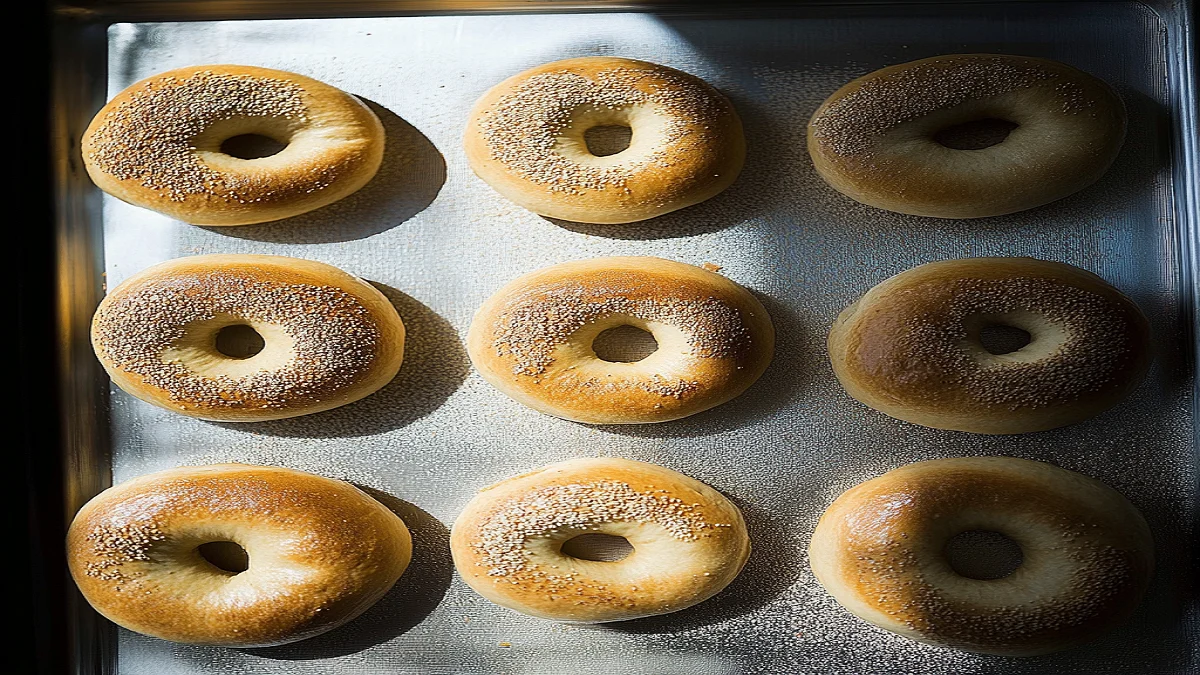There’s something truly special about biting into a warm, chewy bagel with a tangy crust and a soft center. But what if I told you that you can make these delightful bagels at home—from scratch—using the magic of sourdough? If you’re a bagel lover (and let’s face it, who isn’t?), then this sourdough bagel recipe is going to be a game-changer for your kitchen.
Sourdough bagels have a unique depth of flavor thanks to the wild fermentation process, which brings a tanginess that regular bagels just can’t match. And let’s not forget the texture—thick, chewy, with a crisp crust that’s perfect for a hearty breakfast or snack. So, grab your apron, and let’s get started. Trust me, once you try this recipe, you won’t go back to store-bought bagels.
Why Sourdough Bagels?
Before we dive into the recipe, let’s talk about why you should make sourdough bagels instead of just buying them from the store. First off, there’s something about the art of sourdough that makes the whole experience feel special. You’re creating a wild yeast starter, nurturing it, and transforming it into the most satisfying, chewy bread imaginable. It’s like you’re bringing a little piece of bakery magic right into your home kitchen.
But the main reason? The flavor and texture. The slow fermentation process of sourdough bagels results in a deep, slightly tangy taste that’s unique to sourdough. This tanginess comes from the natural acids produced by the wild yeast and bacteria in your starter. The result? An unforgettable bagel that’s not only more flavorful but more digestible as well!
For a twist, why not add some homemade strawberry cream cheese to your freshly made bagel? It’s the perfect pairing to elevate your breakfast experience!
Why Homemade Sourdough Bagel Recipe Are Worth Making
Making your own fermented dough into tasty homemade bagels is a fun and rewarding task. It offers many benefits, like better digestibility and saving money. You can also make your homemade bagels just the way you like them.
Health Benefits of Fermented Bread
The way sourdough bread is made makes its nutrients easier for our bodies to use. It’s kinder to our stomachs than regular bread. It might even help if you have gluten issues.
Cost Savings of Baking at Home
By baking your own homemade bagels, you can save a lot of money. You get to pick what goes into them, so they’re cheaper and just as good as store-bought ones.
Customization Possibilities Sourdough Bagel Recipe
One of the best things about making your own homemade bagels is trying new things. You can add special ingredients or toppings. This lets you make your sourdough bagel just how you like it.
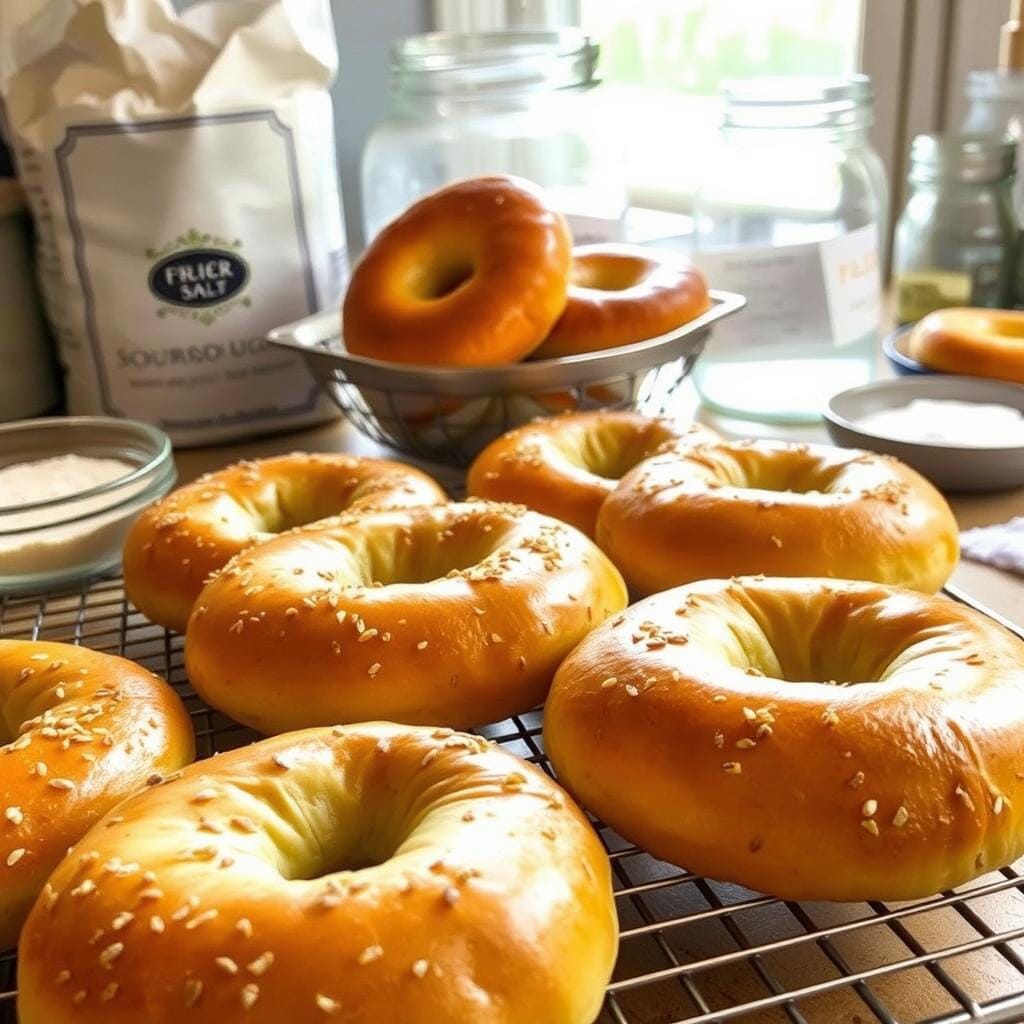
“Baking your own fermented dough into homemade bagels allows you to savor the art of artisanal bread-making and enjoy the many benefits it provides.”
Essential Ingredients for Sourdough Bagel Recipe
Making perfect sourdough bagels needs the right ingredients. At the core is bread flour, a high-protein flour that gives your bagels a chewy texture. This flour pairs with an active sourdough starter to create a tangy flavor. This flavor makes sourdough bagels different from regular ones.
You can also add optional additions to make your sourdough bagels even better. Try adding spices, herbs, or savory toppings. These can change your bagels into something truly special.
Knowing how each ingredient works in your sourdough bagel recipe is key. It helps you make the perfect homemade sourdough bagel. Let’s look at the main ingredients that make these bagels so great.
| Ingredient | Purpose |
|---|---|
| Bread Flour | Provides the high-protein content necessary for the desired chewy texture of sourdough bagels. |
| Sourdough Starter | Contributes to the distinctive tangy flavor and natural leavening of the dough. |
| Optional Additions | Spices, herbs, and toppings can be used to customize the flavor profile of your sourdough bagels. |
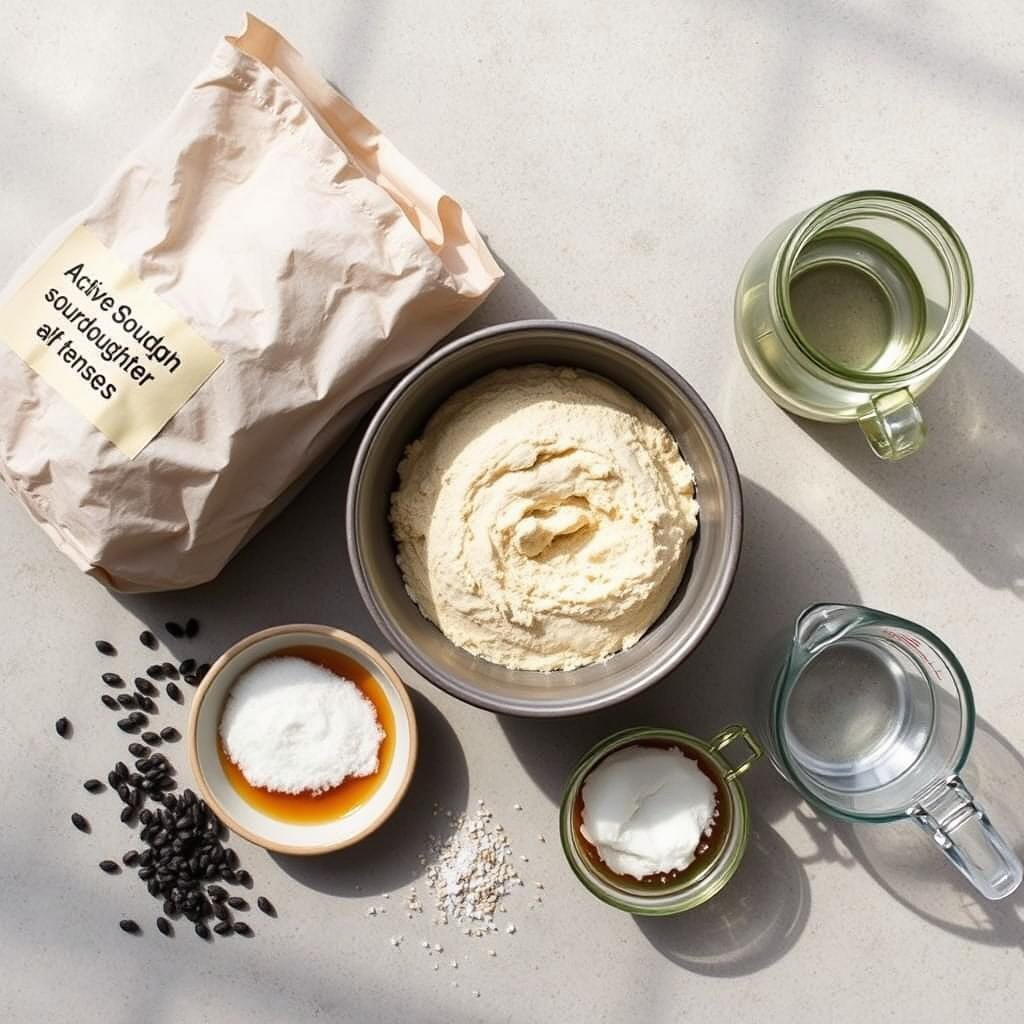
“Homemade sourdough bagels are a labor of love, but the end result is well worth the effort. The combination of high-quality bread flour and a vibrant sourdough starter creates a bagel that is truly unparalleled in taste and texture.”
Equipment You’ll Need for Sourdough Bagel Recipe
Making delicious homemade sourdough bagels needs the right tools. You’ll need essential baking items and some optional gadgets. The right setup can make a big difference in your bagel-making success. Let’s look at the must-have items and tools for temperature control that will improve your bagel-making experience.
Must-Have Baking Tools
- A sturdy stand mixer or bread machine to knead the dough effectively
- A large mixing bowl for the initial dough preparation
- A sharp knife or bench scraper for cutting and shaping the bagels
- A rimmed baking sheet or pizza stone for baking the bagels
- A slotted spoon or skimmer for boiling the bagels
Optional but Helpful Equipment
While not essential, these items can improve your baking and bagel quality:
- A kitchen scale for precise ingredient measurements
- A baking peel or pizza peel to transfer the bagels in and out of the oven
- A silicone baking mat or parchment paper for lining the baking sheet
- A dough proofer or proofing box to maintain optimal temperature and humidity during the proofing stage
Temperature Control Tools
Keeping the right temperature is key for proofing and baking your homemade bagels. Here are tools for precise temperature control:
- A digital oven thermometer to accurately monitor your oven’s temperature
- An instant-read thermometer to check the internal temperature of the bagels during baking
- A kitchen timer or stopwatch to track the precise boiling and baking times
With the right baking techniques and equipment, you’ll make perfect sourdough bagels at home.
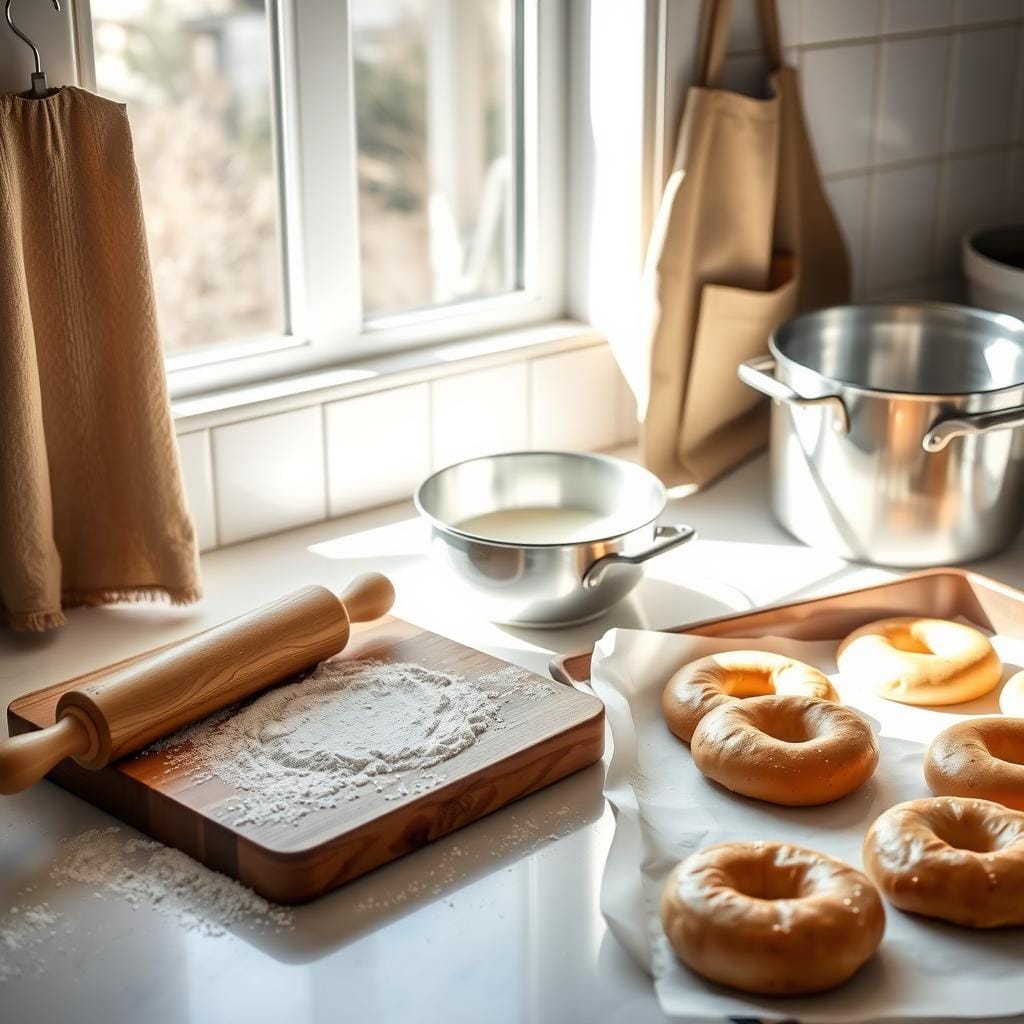
Understanding Your Sourdough Starter
At the heart of the perfect sourdough bagel recipe is a thriving fermented dough starter. This starter is a mix of wild yeast and good bacteria. It’s what makes artisanal artisanal bread taste and feel special. Knowing how to care for your sourdough starter is key to baking tasty fermented dough bagels at home.
To make your sourdough bagel recipe a hit, watch your starter closely. Feed it regularly, check its rise and fall, and adjust its moisture as needed. A healthy starter means your artisanal bread will be chewy and full of flavor.
Getting good at sourdough starter care takes time and effort. But the results are worth it. With patience and attention, you can use wild yeast to make your fermented dough bagels even better.
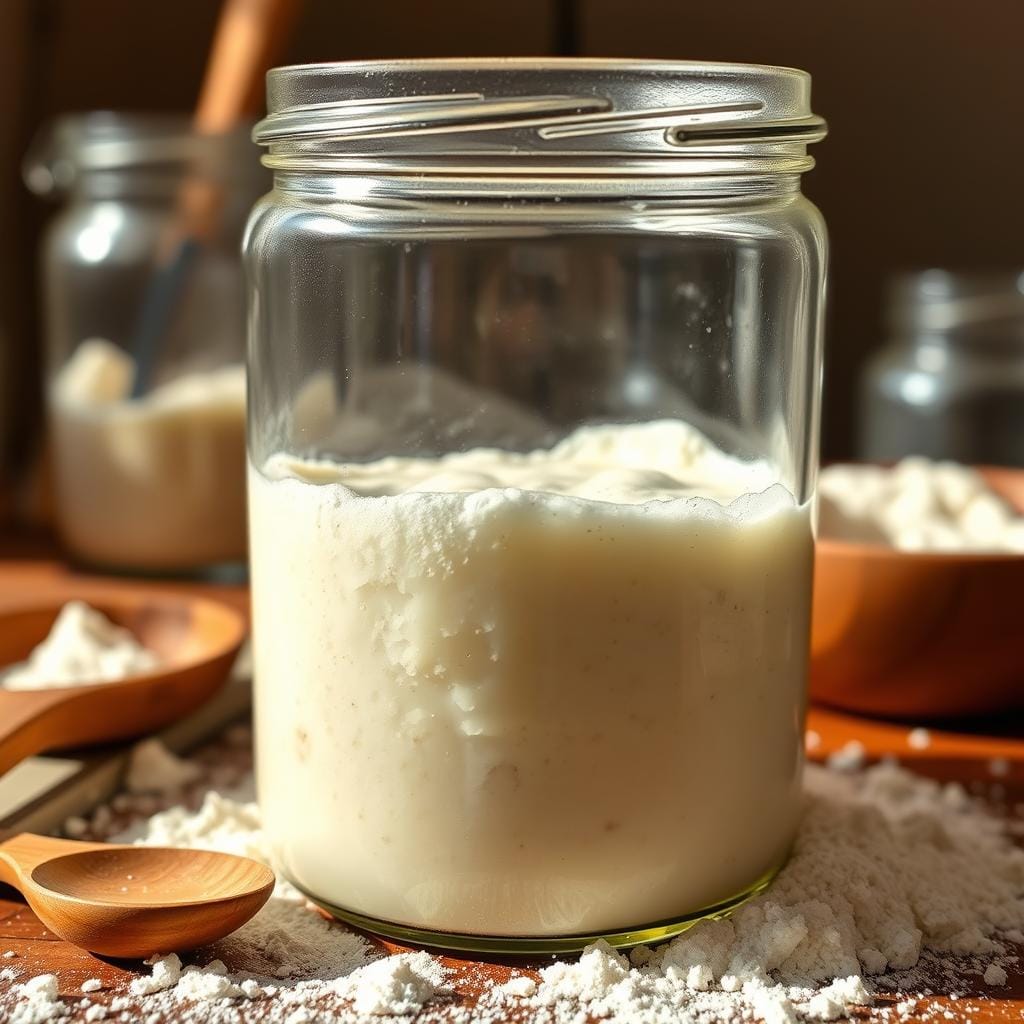
“A healthy sourdough starter is the foundation for exceptional artisanal bread. It’s a living, breathing ingredient that requires your care and attention.”
Step-by-Step Mixing and Kneading Process Sourdough Bagel Recipe
Making the perfect sourdough bagel begins with mixing and kneading the dough. Learning the right techniques is key. This helps you get the dough just right for that chewy texture in your homemade bagels.
Proper Dough Consistency
A successful sourdough bagel dough needs the right consistency. It should be firm but still pliable, not too sticky or dry. A good dough is smooth and elastic, keeping its shape well.
To get this, mix the dough with the right amount of bread flour, water, and sourdough starter.
Kneading Techniques
- Use a sturdy stand mixer with a dough hook attachment to knead the dough for 8-10 minutes, or knead by hand for 12-15 minutes.
- Apply a gentle, rhythmic motion, pushing the dough away from you, then folding it back towards you.
- Add small amounts of bread flour as needed to prevent sticking, but avoid over-flouring, which can result in a dry, tough dough.
Visual Cues for Perfect Dough
Watch for these signs as you knead the dough:
- The dough should form a smooth, elastic ball that passes the “windowpane test” – you should be able to stretch a small piece of dough thin enough to see light through it without it tearing.
- The dough should feel slightly tacky but not overly sticky, and it should hold its shape when formed into a ball.
- When you poke the dough with your finger, it should slowly spring back, indicating the gluten development is on point.
By following these mixing and kneading guidelines, you’ll be well on your way to crafting homemade bagels with an irresistible texture and flavor.
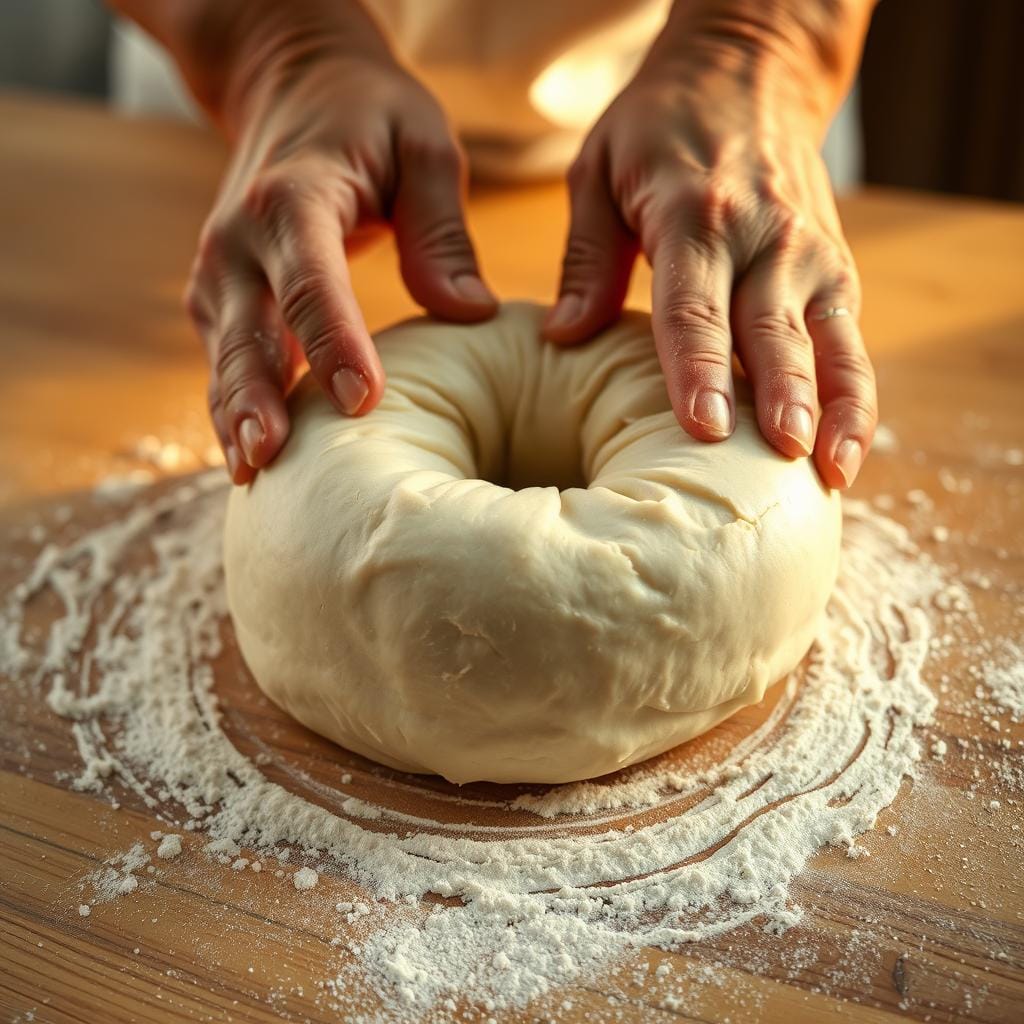
Shaping and Proofing Your Sourdough Bagel Recipe
Making the perfect homemade sourdough bagel is an art that needs precision and patience. The steps of shaping and proofing are key to the bagel’s texture and taste. Learning these skills will help you make bakery-quality bagels at home.
Start by splitting your dough into equal parts and shape each into a round ball. Roll the dough into a smooth, tight surface without overworking it. Then, use your index finger to make a hole in the middle of each ball. Stretch the dough out to form the bagel shape.
- Carefully shape the dough into round, even balls.
- Poke a hole through the center of each ball, gently stretching the dough to create the bagel shape.
- Ensure the dough is taut and smooth on the surface.
The proofing stage is the last step, where the bagels rest and rise slowly. This step is crucial for the dough’s chewy texture and rich flavors. Place the bagels on a greased baking sheet, cover them, and let them proof for 30-60 minutes. They should grow by about 50% in size.
| Proofing Time | Dough Increase | Ideal Texture |
|---|---|---|
| 30 minutes | 25-35% | Tight, dense |
| 45 minutes | 40-50% | Chewy, slightly airy |
| 60 minutes | 50-60% | Chewy, well-developed |
By learning how to shape and proof, you’ll make amazing homemade sourdough bagels. They’ll impress your family and friends.
The Art of Boiling Bagels
Boiling your bagels before baking is key to getting that chewy texture and golden crust. This step is crucial for perfect homemade bagels. It also lets you try out different baking techniques to make your boiling bagels even better.
Water Bath Additions
The water bath is where the magic happens for boiling bagels. You can make your bagels taste and feel better by adding a few things to the water:
- Baking soda: A tablespoon or two in the water bath makes the crust shiny and golden.
- Malt syrup or honey: A little bit of these sweeteners adds a tasty flavor to your homemade bagels.
- Spices: Try adding a pinch of cinnamon, nutmeg, or a dash of cayenne pepper for unique tastes in your boiling bagels.
Timing and Temperature Control
Getting the timing and temperature right is important for boiling. The water should be between 212°F and 216°F (100°C to 102°C). Boil the bagels for 60-90 seconds on each side. This ensures they cook evenly and get that perfect chew. Adjust the time and temperature to get the results you want.
Mastering the art of boiling bagels will help you make homemade bagels that look great and taste amazing. Try different techniques and ingredients to find what you like best.
Baking Techniques for Perfect Crust
To get a golden, crispy crust on your homemade sourdough bagels, you need some expert baking tricks. The goal is to create the perfect baking environment. This helps your bagels develop a beautiful, artisanal bread crust.
Start by heating your oven to a high temperature, about 450°F (230°C). This high baking temperature helps the bagels get a quick, satisfying crust. Also, adding steam in the oven’s early stages can make the crust even better.
- Place a shallow baking dish or metal pan on the bottom rack of your preheated oven.
- Just before putting the bagels in the oven, pour 1 cup of hot water into the pan to create steam.
- Quickly close the oven door to trap the steam, and bake the bagels for 12-15 minutes.
Consider using bread scoring too. This means making shallow cuts or slashes on the bagels’ top before baking. It helps the crust expand and look more artisanal. Use a sharp knife or lame to make 1-2 diagonal cuts about 1/2 inch deep across the top of each bagel.
“The key to a perfect crust is a combination of high heat and steam. The steam helps the bagels develop that signature shiny, crackly exterior.”
By using these baking techniques, you can get the baking temperature, steam, and optional bread scoring needed for a delightful, golden-brown crust on your homemade artisanal bread bagels.

Storage and Reheating Tips for Sourdough Bagel Recipe
Keeping your homemade sourdough bagels fresh and flavorful is key. You can enjoy them for a few days or freeze them for longer. There are ways to keep your artisanal bread in great shape.
Effective Freezing Methods
Freezing is a great way to store your homemade bagels for a long time. Here’s how to freeze them:
- Let the bagels cool down completely before freezing.
- Wrap each bagel in plastic wrap or aluminum foil to avoid freezer burn.
- Put the wrapped bagels in a resealable freezer bag or airtight container.
- Make sure to squeeze out any air before sealing the bag or container.
- Freeze the bagels for up to 3 months.
Maintaining Freshness After Baking
If you want to enjoy your sourdough bagels within a few days, here’s what to do:
- Store the cooled bagels in a paper bag or bread box at room temperature.
- Don’t put the bagels in a plastic bag, as it can make them soggy.
- For the best taste, eat the bagels within 3-4 days of baking.
Using the right storage and reheating methods will let you enjoy your sourdough bagels for longer. Try different baking techniques to find the best way to store your artisanal bread.
Nutritional Facts (Per Serving – 1 Bagel):
- Calories: 250
- Protein: 9g
- Fat: 1g
- Carbs: 50g
- Fiber: 2g
- Sugar: 4g
- Sodium: 500mg
Conclusion
Congratulations, you’ve mastered the art of making delicious sourdough bagels in your kitchen! This guide has shown you how to bake tasty, chewy, and perfectly textured homemade bagels. Creating this artisanal bread has been rewarding and fulfilling.
Now, keep improving your sourdough bagel recipe. Try different toppings, shapes, and flavors. Baking homemade bagels lets you explore endless possibilities. Let your creativity and passion for cooking show.
For the best sourdough bagels, know your starter, make great dough, and control boiling and baking. With time and effort, you’ll make artisanal bread that wows everyone.
FAQs About Sourdough Bagel Recipe
1. Are sourdough bagels healthier than regular bagels?
Sourdough bagels can be considered slightly healthier than regular bagels for a few reasons. The fermentation process involved in making sourdough breaks down some of the gluten and phytic acid, making it easier to digest and potentially improving nutrient absorption. The natural fermentation also creates beneficial bacteria (probiotics) that can aid in gut health. Additionally, sourdough often uses whole grain flours, which are higher in fiber and nutrients compared to refined flour used in regular bagels. That said, both types of bagels can be high in carbs and calories, so moderation is key.
2. Do sourdough bagels taste different?
Yes, sourdough bagels do have a different taste! Due to the natural fermentation process, sourdough bagels tend to have a tangy or slightly sour flavor compared to regular bagels. The wild yeast and bacteria used in sourdough create a more complex taste profile. The texture also differs; sourdough bagels are often chewier with a denser crumb, which some people prefer. So if you enjoy a bit of tanginess in your bread, sourdough bagels might be your new favorite!
3. Why are my sourdough bagels so tough?
Tough sourdough bagels can be the result of a few factors. One common issue is overworking the dough, which develops too much gluten, making the bagels dense and chewy. Another possibility is under-proofing—if the dough doesn’t have enough time to rise, the bagels won’t have that light, airy texture. Also, the boiling time before baking is crucial: bagels need to be boiled long enough to form a crust but not too long, or they may become tough. Lastly, using the wrong flour or not maintaining the proper hydration level can affect the texture.

